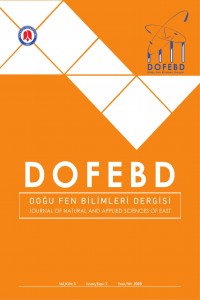Abstract
Soda gölleri, pH değerinin yüksek olduğu (9.0 -12.0), yeryüzündeki doğal alkalin ortamlardır. Bu alanlar sıradışı jeokimyaları nedeniyle, çok sayıda ekolojik ve ekonomik öneme sahip mikrobiyal topluluk barındırlar. Van Gölü, büyük bir havzanın alçak kısmını kaplayan dünyanın en büyük soda gölüdür. Göl kendine has su kimyası ile diğer soda göllerinin içinde özel bir yere sahiptir. Dünya genelinde soda göllerindeki mikroorganizmalar üzerine yapılan çalışmalar her geçen gün artmaktadır. Ağır metaller mikro kirleticilerdir ve birikimleri özellikle sucul sistemleri tehdit etmektedir. Bakteriyal komüniteler çevresel değişimlere karşı oldukça duyarlıdırlar. Şehirleşmenin ve sanayileşmenin getirdiği en kötü sonuçlardan biri olan ağır metal varlığı da bakteriler üzerinde negatif etki yaratmaktadır. Böyle bir stresin Van Gölü’nün doğal bakteri populasyonunda nasıl bir etkiye neden olduğunu görmek için kadmiyum, bakır ve çinko varlığındaki sayısal değişimleri incelenmiştir. Buna göre gölün iki farklı kıyısından alınan örneklerde de paralel sonuçlar gözlenmiştir. Van Gölü sedimentinin kültüre edilebilen bakteri sayısı 106 KOB/g olarak bulunmuştur. Ağır metaller açısından değerlendirildiğinde ise kadmiyumun her iki bölgede de en toksik olduğu belirlenmiştir.
Keywords
Supporting Institution
Van YYÜ BAP
Project Number
FYL-2018-7188
Thanks
Bu çalışma Van Yüzüncü Yıl Üniversitesi Bilimsel Araştırma Projeleri (BAP) tarafından desteklenmiştir (FYL-2018-7188).
References
- Adhikari, R., Glombitza, C., Nickel, J. C., Anderson, C. H., Dunlea, A. G., Spivack, A. J., Murray, R. W., D’Hondt, S., Kallmeyer, J., (2016). Hydrogen utilization potential in subsurface sediments. Frontiers in Microbiology, 7: 1-16. https://doi.org/10.3389/fmicb.2016.00008
- Amin, M. H. M., Chowdhury, A. J. K., Yunus, K., Nordin, N. F. H., (2015). Spatial and temporal distribution of bacterial communities and heavy metals (Cr, Cd and Pb) composition in sediments along Pahang River, Malaysia. Jurnal Teknologi, 77: 71-76. https://doi.org/10.11113/jt.v77.6710
- Ateş, Ö., Öner, E. T., Arıkan, B., Denizci, A. A., Kazan, D., (2007). Isolation and identification of alkaline protease producer halotolerant Bacillus Licheniformis Strain BA17. Annals of Microbiology, 57: 369-375. https://doi.org/10.1007/BF03175075
- Avşar, C., Yeğin, Z., Civek, S., Berber, I., (2016). The genetic heterogeneity of facultative alkaliphilic Bacillus species isolated from soda lake. Fresenius Environmental Bulletin, 25: 4103-4110.
- Budakoğlu, M., (2009). Comparison of recent siliceous and carbonate mat development on the shore of hyper-alkaline Lake Van and Mt. Nemrut Soğuk Lake, NE Anatolia, Turkey. Geomicrobiology Journal, 26: 146-160. https://doi.org/10.1080/01490450802675027
- Choudhury, R., Srivastava, S., (2001). Zinc resistance mechanisms in bacteria. Current Science, 81: 768-775. https://www.jstor.org/stable/24106396
- Grant, W. D., Mwatha, W. E., Jones, B. E., (1990). Alkaliphiles: ecology, diversity and applications. FEMS Microbiology Reviews, 75: 255-270. https://doi.org/10.1111/j.1574-6968.1990.tb04099.x
- Hall, L. W., Anderson, R. D., (1999). A deterministic ecological risk assessment for copper in European saltwater environments. Marine Pollution Bulletin, 38: 207-218. https://doi.org/10.1016/S0025-326X(98)00164-7
- Joshi, A. A., Kanekar, P. P., Kelkar, A. S., Shouche, Y. S., Vani, A. A., Borgave, S. B., Sarnaik, S. S., (2008). Cultivable bacterial diversity of alkaline Lonar Lake, India. Microbial Ecology, 55: 163–172. https://doi.org/10.1007/s00248-007-9264-8
- Kallmeyer, J., Grewe, S., Glombitza, C., Kitte, J. A., (2015). Microbial abundance in lacustrine sediments: a case study from Lake Van, Turkey. International Journal of Earth Sciences. 104: 1667-1677. https://doi.org/10.1007/s00531-015-1219-6
- Kempe, S., Kazmierczak, J., Landmann, G., Konuk T., Reimer A., Lipp A., (1991). Largest known microbialities discovered in Lake Van, Turkey. Letters to Nature, 349: 605-608. https://doi.org/10.1038/349605a0
- Landmann, G., Reimer, A., Lemcke, G., Kempe, S., (1996). Dating late glacial abrubt climate changes in the 14,570 yr long continuous varve record of Lake Van, Turkey. Palaeo, 122, 107-118. https://doi.org/10.1016/0031-0182(95)00101-8
- Lin, Y. C., Chang-Chien, G. P., Chiang P. C., Chen, W. H., Lin, Y. C., (2013). Multivariate analysis of heavy metal contaminations in seawater and sediments from a heavily industrialized harbor in Southern Taiwan. Marine Pollution Bulletin, 76: 266-275. https://doi.org/10.1016/j.marpolbul.2013.08.027
- Liu, G., Rajendran, N., Amemiya, T. Itoh, K., (2011). Bacterial community structure analysis of sediment in the Sagami River, Japan using a rapid approach based on two-dimensional DNA gel electrophoresis mapping with selective primer pairs. Environmental Monitoring and Assessment, 182: 187–195. https://doi.org/10.1007/s10661-010-1868-7
- Llamado, A. L., Raymundo, A. K., Aggangan, N. S., Pampolina, N. M., Cadiz, N. M., (2013). Enhanced rhizosphere bacterial population in an abandoned copper mined-out area planted with Jatropha interspersed with selected indigenous tree species. Journal of Environmental Science and Management, 16: 45-55.
- López-García, P., Kazmierczak, J., Benzerara, K., Kempe, S., Guyot F., Moreira D., (2005). Bacterial diversity and carbonate precipitation in the giant microbialites from the highly alkaline Lake Van, Turkey. Extremophiles, 9: 263-274. https://doi.org/10.1007/s00792-005-0457-0
- Ohji, M., Harino, H., Langston, W. J., (2019). Differences in susceptibility of marine bacterial communities to metal pyrithiones, their degradation compounds and organotin antifouling biocides. Journal of the Marine Biological Association of the United Kingdom, 99: 1033-1039. doi:10. 1017/S0025315418001169
- Reimer, A., Landmann, G., Kempe, S., (2009). Lake Van, Eastern Anatolia, hydrochemistry and history. Aquatic Geochemistry, 15: 195-222. https://doi.org/10.1007/s10498-008-9049-9
- Sorokin, D. Y., Kuenen, J. G., Muyzer, G., (2011). The microbial sulfur cycle at extremely haloalkaline conditions of soda lakes. Frontiers in Microbiology, 2: 44, 1-16. https://doi.org/10.3389/fmicb.2011.00044
- Trevors, J. T., Stratton, G. W., Gadd, G. M., (1986). Cadmium transport, resistance, and toxicity in bacteria, algae, and fungi. Canadian Journal of Microbiology, 32: 447-464. https://doi.org/10.1139/m86-085
- Zahir, M. S. M., John, B. A. , Kamaruzzaman, B. Y. ve ark., (2012). The distribution of selected metals in the surface sediment of Langkawi Coast, Malaysia. Oriental Journal of Chemistry, 28: 725-732.
- Zhang, H., Yang, M., Shi, W. Zheng, Y., Sha, T., Zhao, Z. W., (2007). Bacterial diversity in mine tailings compared by cultivation and cultivation-independent methods and their resistance to lead and cadmium. Microbial Ecology, 54, 705–712. https://doi.org/10.1007/s00248-007-9229-y
Details
| Primary Language | Turkish |
|---|---|
| Journal Section | Articles |
| Authors | |
| Project Number | FYL-2018-7188 |
| Publication Date | March 30, 2019 |
| Submission Date | February 13, 2020 |
| Published in Issue | Year 2020 Volume: 3 Issue: 1 |

